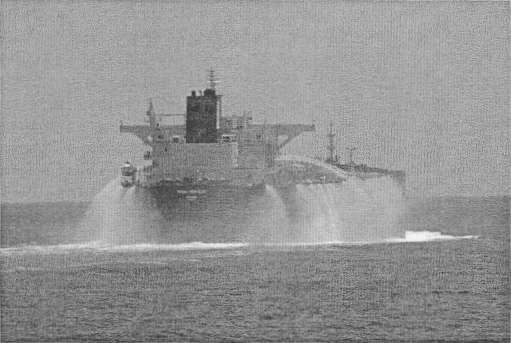- Author
- Periodical, Semaphore
- Subjects
- RAN operations, Post WWII
- Tags
-
- RAN Ships
- HMAS Ballarat II, HMAS Sydney IV
- Publication
- December 2009 edition of the Naval Historical Review (all rights reserved)
By 1210 Sydney sighted the skiffs which appeared to disengage from Dubai Princess once they saw two warships approaching at speed. One skiff closed on Sydney initially, but then stopped and waved a white flag and a jerry (fuel) can, trying to show that they meant no harm and needed fuel. Sydney continued closing on Dubai Princess and by 1220 had established a position off her port quarter with the aim of remaining there while she continued her transit west. The initial plan had Ballarat close to the starboard quarter, but at 1227 a second vessel, MV MSC Stella, 6nm east (i.e. behind) and travelling in the same direction, reported that she now had a skiff approaching her. Ballarat closed on MSC Stella to provide her with the same level of escort that Sydney was providing to Dubai Princess.
Soon afterwards, Sydney’s helicopter reported a possible pirate mother ship a further 20nm east and was tasked to investigate further. With Dubai Princess now apparently clear of danger, and MSC Stella reasonably close, Ballarat was tasked to escort both ships as they cleared the danger area to the west, while Sydney, with her greater speed, reversed course and closed on the possible mother ship. Sydney steamed back past the original skiff and those onboard were again seen waving fuel cans in the air. The skiff’s position was recorded and Sydney continued to close on the suspected mother ship, which turned out to be another large skiff with fuel tanks visible on her deck. While these tanks were possibly for fuel storage, there was no other direct evidence linking her to the attacking skiffs.
At 1345 Dubai Princess and MSC Stella were now well clear of possible danger, so Ballarat reversed course to join the next group of six merchant ships that were sailing west down the transit corridor as a close escort. At one stage the second of these ships reported a skiff closing, but it quickly turned away with Ballarat’s arrival. Meanwhile Sydney returned to the stationary skiff to find the crew still waving fuel cans around, and she remained in the area pending the arrival of a ship from Task Force 151. Given that the skiffs had already fired upon Dubai Princess – although no firings were witnessed by either Sydney or Ballarat – there was a clear risk in attempting a boarding, so Sydney kept the vessel under observation.

The skiff was in no apparent distress and as the afternoon wore on it became apparent that she had, indeed, run out of fuel.
Fortunately, Ballarat had been fitted with a secure, web-based communications capability which was required for her subsequent work in the United Kingdom. This system allowed relatively easy and secure communications with both CMF Headquarters and associated ships, so Ballarat acted as the key communication hub. This communications path allowed the Commander of Task Force 151 to direct one of his ships, USS New Orleans, to join Sydney and assume responsibility for the situation, allowing Sydney to continue her transit to re-join Ballarat. At 1715 New Orleans arrived on the scene and after a radio discussion a small team from Sydney was transferred across to New Orleans to provide a first-hand briefing. The team returned to Sydney at 1830 and the ship continued her passage along the transit corridor.
While this event proved relatively straightforward in hindsight, it does provide a very good example of the flexibility and reach of naval forces. Ships underway are always moving and can respond at very short notice to events as they unfold – they are self-contained units with a wide range of inherent skills that can be used whatever situation arises without the need for any external support or assistance. Ships deploying in support of anti-piracy operations received specific training tailored to the mission (as do all ships and units deployed for operations), however the normal ‘baseline’ combat capability that all RAN ships maintain provides an extremely good foundation to deal with most situations that arise at sea. Our ships were well positioned to defend both themselves and the merchant ships, but could immediately have switched to a benign posture and provided assistance if anyone onboard a vessel had become distressed. This ability to tailor – and rapidly change – posture is again a unique and very powerful attribute of sea-based forces.
Another key lesson is the value of operating with other navies on a regular basis. Of course, navies the world over have been operating in coalitions for centuries, but the relative ease with which Sydney and Ballarat could coordinate with CMF Headquarters and other coalition ships in the area was largely because the RAN routinely operates in those waters and with allies. There are RAN officers working within CMF Headquarters and foreign naval officers are on exchange with the RAN, all of which builds trust, teamwork and understanding. When a short notice situation arises, it is relatively easy to coordinate efforts and achieve a positive result for all.
Of course, this is one of the key aspects of NORTHERN TRIDENT 09 – the very reason Sydney and Ballarat are deployed.




